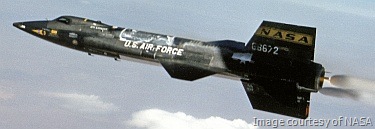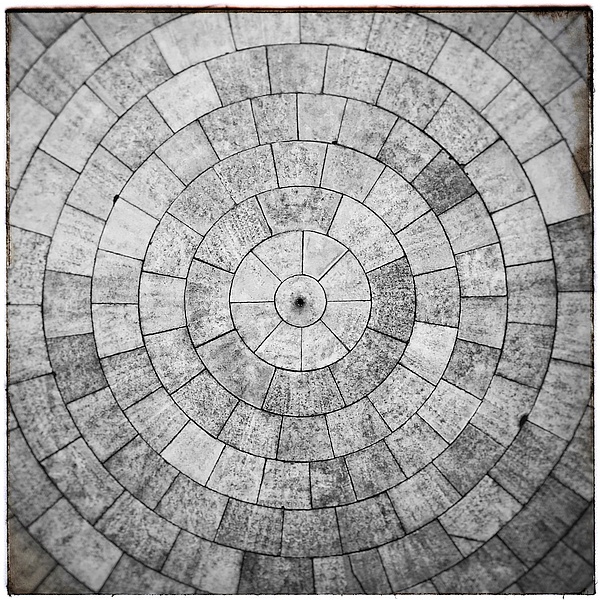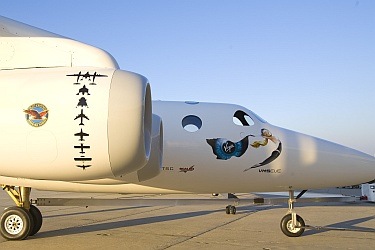Richard Branson and Burt Rutan rolled out the carrier aircraft for their space tourism venture yesterday. Named the White Knight Two, it is a large four-engined jet of unorthodox design, as is Rutan’s habit in all of his shop’s designs. For all of my hesitations about Branson’s endless self-promotion and carrying on, I admire this venture very much, and it demonstrates how two maverick figures like this can advance the state of the art faster than the whole rest of the American aerospace establishment, which has been stagnant in many ways since the North American X-15, and its derivative the Space Shuttle, were designed and flew over thirty years ago.

As an aside, it is worth noting that the X-15 set its record altitude in 1968 (50.6 miles) and its record speed in 1967 (4,519 mph) – over forty years ago! Only in 2004 did Rutan’s SpaceShipOne exceed the X-15’s altitude mark on its fifteenth flight, and set its own mark of 69.6 miles two flights later. Its maximum speed was no match for the X-15, however, although that was not their goal.
Back to my point, the rollout of the White Knight Two displayed the plane’s livery for the first time, and a striking feature, to my spotter’s eye at least, is the repeated motif of a series of aircraft in profile, on the outboard side of the pylons and underneath the plane’s twin booms.
 A bit of googling reveals that Virgin galactic calls this the “DNA of Flight” and I quite admire it. The Space Fellowship indicates the emblem is “inspired by Phillipe Starck,” but I can find no further confirmation of this. Virgin kindly offers this closeup among their press materials. The graphic on the web site omits the top image, which is clearly the Whte Knight Two mated with the forthcoming sub-orbital SpaceShipTwo. Beneath that is the 2004 Rutan SpaceShipOne, and below that the Grumman Lunar Module, first flown in 1968. I take the next image to be a Boeing 747, which makes sense as it was a milestone for commercial aviation and it is also a mainstay of the Virgin Airlines fleet. Below that is, to my eye, the most interesting silhouette of the group, and it triggered this post. I first took it to be a Bell X-1, the first plane to break the sound barrier. A moment’s glance made me rethink that, as the proportions are wrong, the taper and shape of the fuselage, nose, and tail are wrong, and the swept leading edge of the wing with its tip extensions all do not fit. What then? The lack of inlets on the plane is distinctive, and that set my mind to a 1950s Dinky model of a fairly obscure French plane that was among my father’s toys. The Leduc 010 was a very advanced pioneering effort in ramjet research, which took place immediately after World War II. Like the Rutan effort, it relied on a mothership and the original Leduc featured the same ‘wiffleball’ portholes as the SpaceShipOne used for pilot visibility. I could well be wrong about my Leduc suggestion, and if you have another suggestion, or can confirm it for sure, I ask you please to comment below with what you know. Below the Leduc one finds Lindbergh’s Ryan NYP “Spirit of St. Louis”, a Wright Flyer, and (presumably) Daedalus. I suppose it could be Icarus, but since he crashed, I imagine Virgin imagines it to be his more temperate father.
A bit of googling reveals that Virgin galactic calls this the “DNA of Flight” and I quite admire it. The Space Fellowship indicates the emblem is “inspired by Phillipe Starck,” but I can find no further confirmation of this. Virgin kindly offers this closeup among their press materials. The graphic on the web site omits the top image, which is clearly the Whte Knight Two mated with the forthcoming sub-orbital SpaceShipTwo. Beneath that is the 2004 Rutan SpaceShipOne, and below that the Grumman Lunar Module, first flown in 1968. I take the next image to be a Boeing 747, which makes sense as it was a milestone for commercial aviation and it is also a mainstay of the Virgin Airlines fleet. Below that is, to my eye, the most interesting silhouette of the group, and it triggered this post. I first took it to be a Bell X-1, the first plane to break the sound barrier. A moment’s glance made me rethink that, as the proportions are wrong, the taper and shape of the fuselage, nose, and tail are wrong, and the swept leading edge of the wing with its tip extensions all do not fit. What then? The lack of inlets on the plane is distinctive, and that set my mind to a 1950s Dinky model of a fairly obscure French plane that was among my father’s toys. The Leduc 010 was a very advanced pioneering effort in ramjet research, which took place immediately after World War II. Like the Rutan effort, it relied on a mothership and the original Leduc featured the same ‘wiffleball’ portholes as the SpaceShipOne used for pilot visibility. I could well be wrong about my Leduc suggestion, and if you have another suggestion, or can confirm it for sure, I ask you please to comment below with what you know. Below the Leduc one finds Lindbergh’s Ryan NYP “Spirit of St. Louis”, a Wright Flyer, and (presumably) Daedalus. I suppose it could be Icarus, but since he crashed, I imagine Virgin imagines it to be his more temperate father.
My hat is off to Virgin Galactic for this stylish emblem, which is wonderful shorthand for the generations of pioneering aviators and aircraft that have paved the way for Virgin Galactic’s bold plans to bring fare paying customers into space.
One final aside: Bill Sweetman has a post this morning on my favorite blog evah, Ares, entitled “White Knight Two and Responsive Space.” It is a valuable look at why this plane it not just a Branson stunt, but could be the basis for a transformative change in the utilization of space. Worth a read. ❖


One thought on “Virgin Galactic’s “DNA of Flight””